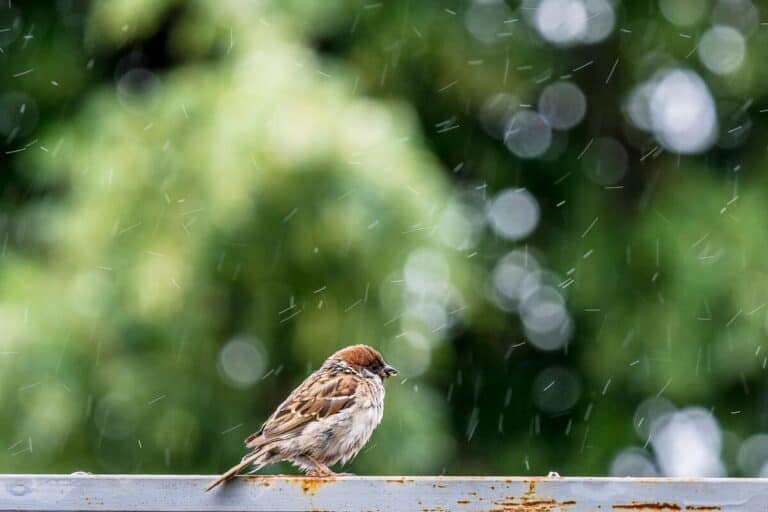How Often You Should Change Bird Bath Water [ANSWERED!]
We’re reader-supported; we may earn a commission from links in this article.
Bird baths can get dirty really fast! So, the water in bird baths needs to be changed often, but how often? I did some research online and came up with an answer that works. Here’s what I found:
Bird bath water should be changed 1 – 2 times a week. However, how often the water in a bird bath should be changed can vary depending on a few factors such as seasonality, bird bath location, the number of birds using the birdbath, and how often the water appears to be discolored.
Bird bath water needs to be changed often to prevent a number of problems. In this article, I’ll cover all the details you need to know so you can get started quickly. Read on to learn more!
TL;DR? Here’s a neat little infographic you can download for reference!
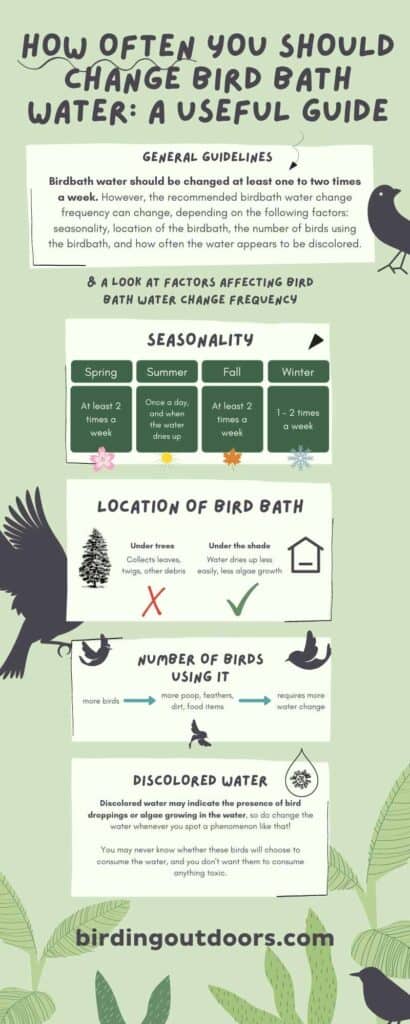
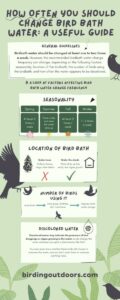
Download the full resolution infographic in my google drive link here!
Bird Bath Water Change Frequency
As mentioned above, bird bath water should be changed at least twice a week. That’s about every other day.
Well, this standard answer was what I came to a conclusion to based on Spring and Fall conditions. The answer actually varies in different conditions. Let’s go through them one by one.
1. Seasonality
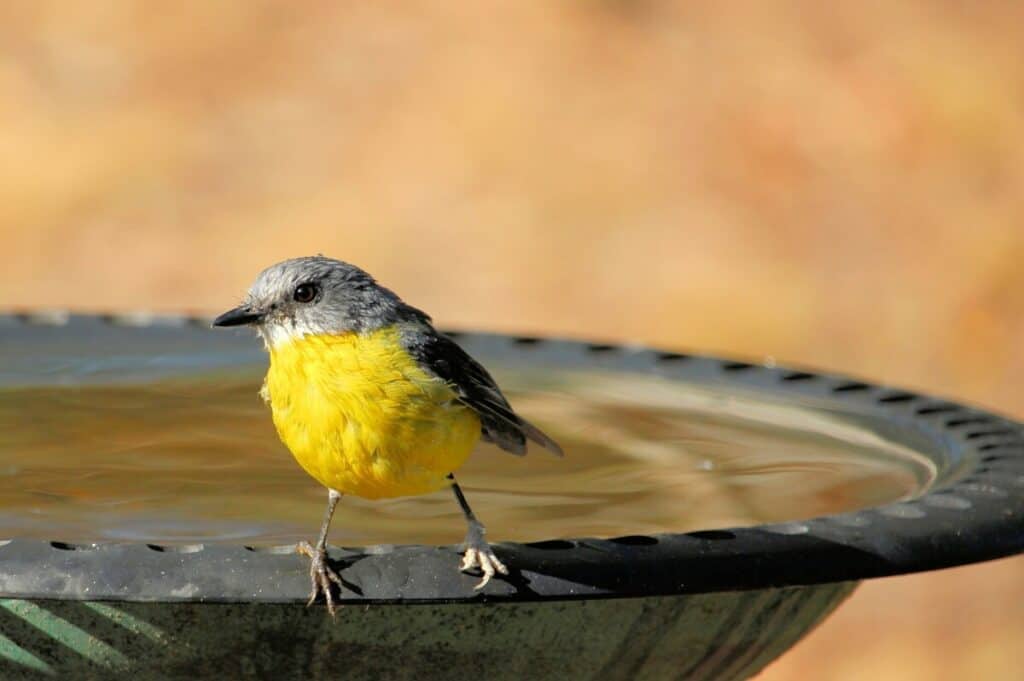
During the summer and winter periods, the frequency of bird bath water changes varies! I did a little digging on Quora forums to get a consensus answer from other bird bath users and came up with the following table:
| Season | Bird Bath Water Change Frequency |
| Spring | At least 2 times a week |
| Summer | Once a day, and when the water dries up |
| Fall | At least 2 times a week |
| Winter | 1 – 2 times a week |
| Season | Spring | Summer | Fall | Winter |
| Bird Bath Water Change Frequency | 2 times a week | Once a day, and when the water dries up | 2 times a week | 1 – 2 times a week |
You’ll see that during the summer, the frequency of bird bath water change increases to once a day. This is because mosquitoes favor laying their eggs in stale water.
If your birds don’t visit your bath all the time, then mosquitoes may lay their eggs inside, so you need to replace the water more often.
Not forgetting the heat that comes with the summer months! The heat can easily dry up the water in your bird bath.
When you notice the water level reducing, I suggest that you also take the time to empty out the remaining water and replacing with fresh tap water, instead of simply topping it up.
I wouldn’t take any chances since you never know if the water already has mosquito larvae or bird poop/other debris.
According to a survey done by experts, respondents actually changed their water more frequently in the summer than in the winter. This applies to respondents in urban and rural environments!
Cleary et al. [1]
I summarized their results below:

During the heat of the summer months, algae also thrive really well! Well, just take it from someone who lives in a tropical climate: me!
Algae thrive on sunlight and in water. I’m sure you don’t want to bathe in algae water, so do change it up if you want the birds to get a clean and refreshing shower!
If you’re new and wondering how high should the water level of a bird bath be when you top it up, I also wrote another blog article on that here. You can check it out if you want a complete answer!
2. Location of Bird Bath
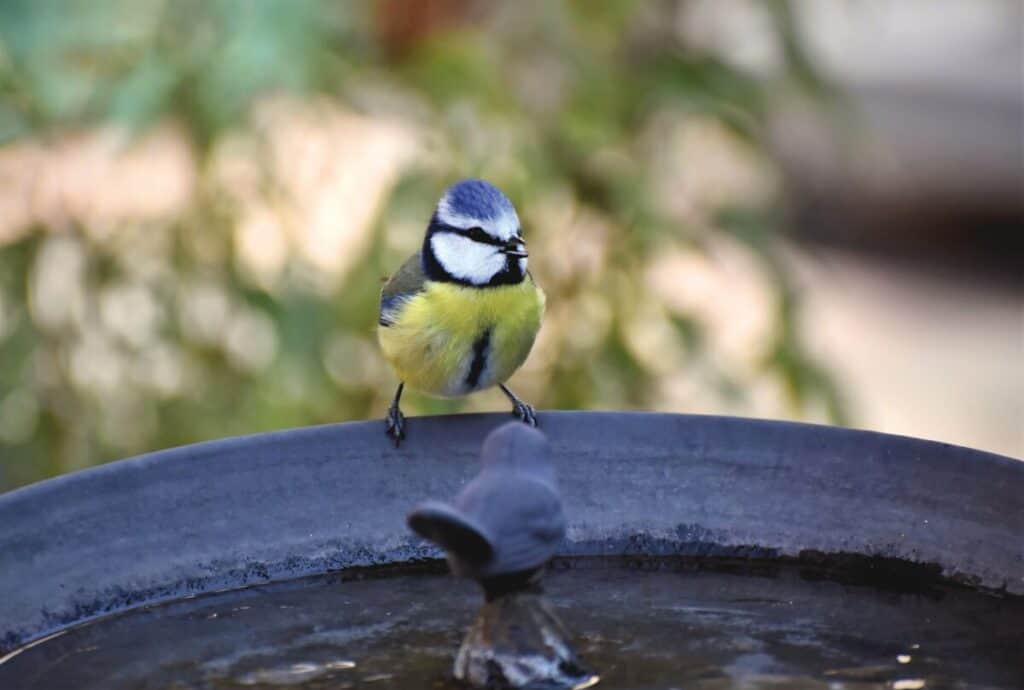
Many gardeners/backyard birders overlook the location of the bird bath. I’m sure you want to reduce the number of times you have to change it right? Or am I the only lazy one?!
Anyway, let’s look at some bird bath locations that require more water change:
| Bird Bath Location | Considerations | Water Change Frequency |
| Under Trees | Lots of leaves, twigs, and debris will fall into bird bath | Higher |
| Under Bird Feeders | Debris, bird droppings, and food items fall into bird bath | Higher |
| Under the shade/a shady spot | Water dries up less easily, less algae growth | Lower |
Just avoid placing your birdbath under trees and under bird feeders to prevent excessive debris from clogging up the water. A good location is within the shade of your porch, where there is ample shade.
Also, according to data gathered by scientists, if you live in a rural environment instead of an urban one, you’ll likely need to change your birdbath water more often. Here’s how the graph looks like:

We can clearly see that rural birdbaths (top 2 bars) have a higher percentage of respondents claiming that they change their waters daily! This means that if you live in a rural environment, you’ll likely need to replace your water more often.
3. Number of Birds Using The Bird Bath
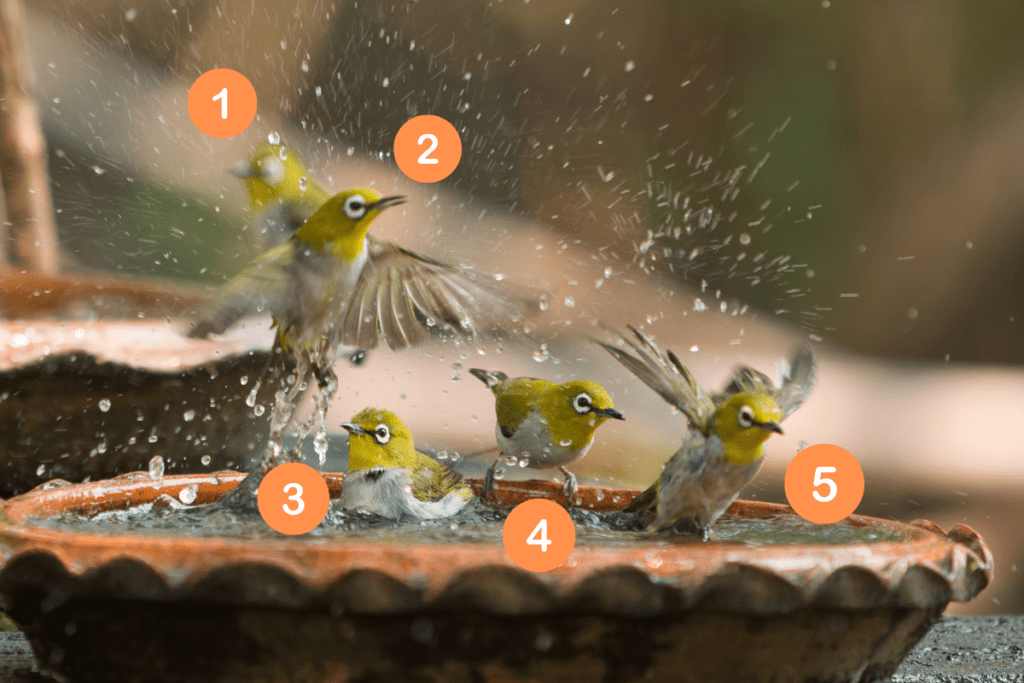
A clean bird bath can be easily made dirty with more birds using it. When more birds using a bath, there is higher tendency for bird droppings, feather, food items, and other dirt to be trapped in the water.
I think it makes sense that as more birds use your bird bath, you should change your water more often. Every bird deserves a clean bath!
4. Discolored Water Color
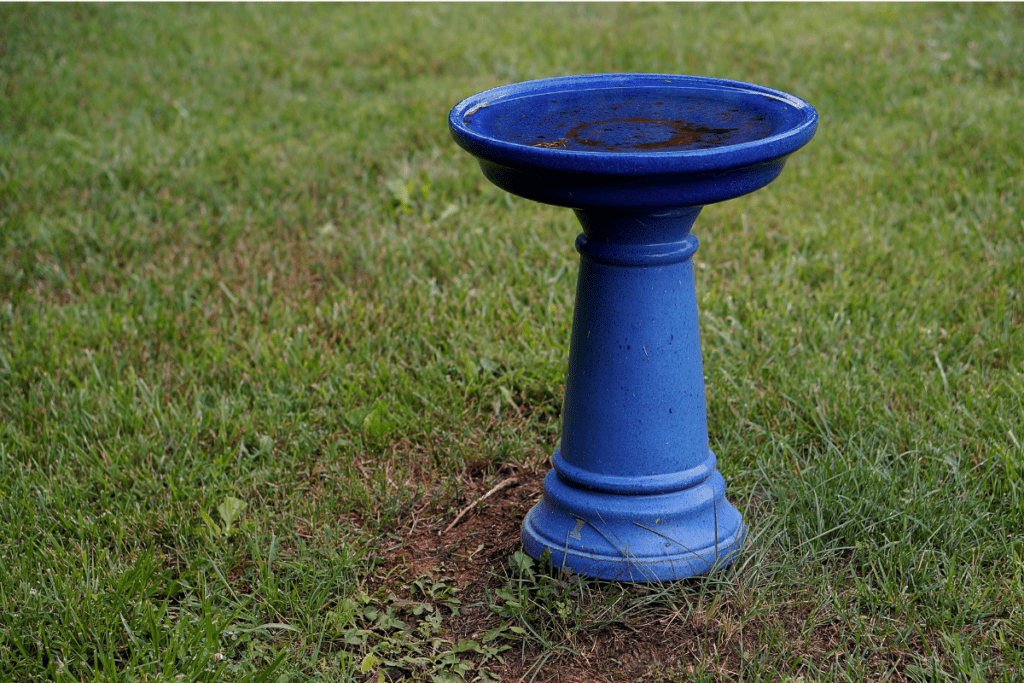
With all the guidelines above applying, discolored water always calls for a fresh change of bathing water for the birds.
You may never know whether these birds will choose to consume the water, and you don’t want them to consume anything toxic.
Discolored water may indicate the presence of bird droppings or algae growing in the water, so do change the water whenever you spot a phenomenon like that!
Other Bird Bath Maintenance Practices
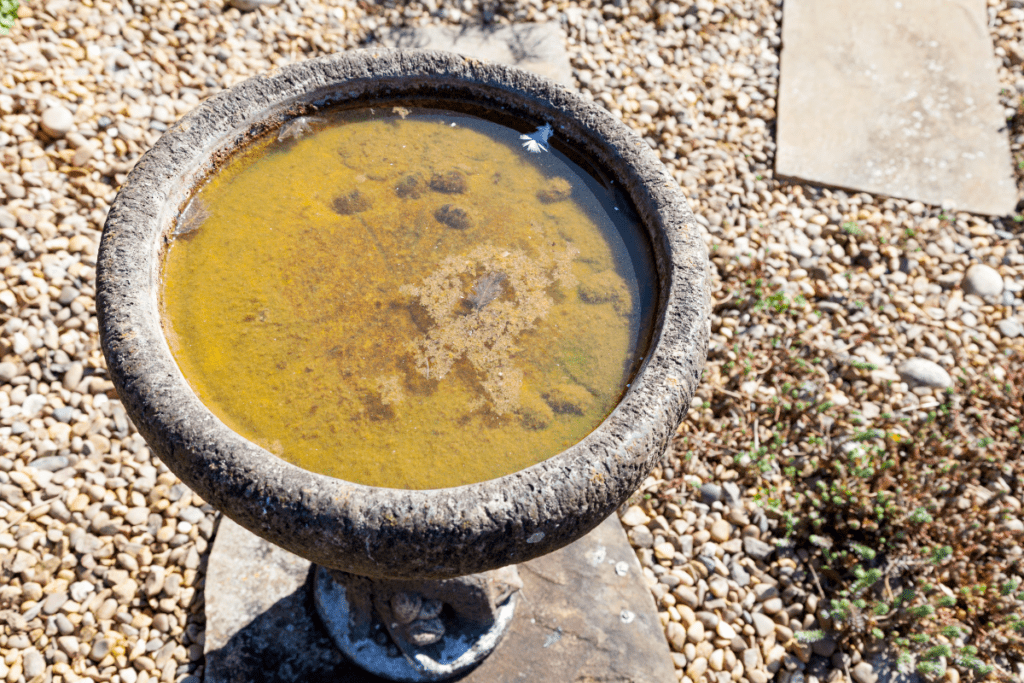
If you’ve changed your bird bath water and want to go the extra mile to keep the basin clean, why not do an occasional routine cleaning to rid your bird bath of all the dirt it had accumulated over time? I
wrote another article right here on this blog on how to keep your bird bath water clean and a stepwise process on how to clean it. Check the article out here.
Final Thoughts
Now you’ve learnt how often bird bath water needs to be changed, let’s all be responsible bird bath owners who can take good care of cleanliness of our bird baths!
Dirty bird baths can have nasty implications like more mosquitoes in the summer, and more undesirable water-borne diseases. I hope that you’ve found this article to be useful and happy birding!
I would like to thank Grainne Cleary for her dedication and research on birdbath hygiene. Her data was proved very useful in writing this article. Visit her website here: http://grainnecleary.com/
References
- Gráinne P. Cleary, Bill R. Coleman, Adrian Davis, Darryl N. Jones, Kelly K. Miller, Holly Parsons, Keeping it clean: bird bath hygiene in urban and rural areas, Journal of Urban Ecology, Volume 2, Issue 1, 2016, juw005, https://doi.org/10.1093/jue/juw005
My Recommended Birding Resources:
Hey there, Justin here!
Here’s a list of all my favorite resources, products, and brands I trust and love.
My Celestron Nature DX 8×42 Binoculars: It’s a great budget pair for beginner birders. Highly valued for its price! Read my review.
Safe Paint for Bird Baths Guide: Learn about non-toxic paint for painting bird baths.
Safe Sealers for Bird Baths Guide: Learn which sealers are safe for bird baths.
Safe Paint for Bird Feeders Guide: Learn what special care needs to be taken to paint bird feeders with the right paint.
Safe Paint for Birdhouses Guide: Learn about non-toxic paint for painting birdhouses. (Not the same as bird baths!)
Bird Identification Apps Guide: 2 of my favorite birding apps are Merlin Bird ID, and eBird Mobile! Merlin is great for tracking and identifying birds, and eBird Mobile is great for tracking the birds sighted when birding.
Check out my resources page for the full list of resources I recommend!

Justin Chia
Justin is the founder and author of Birding Outdoors. He is a Nanyang Technological University (NTU) alumnus with a Bachelor of Biological Sciences and a former data analyst.
Now, Justin runs the Birding Outdoors blog full-time, hoping to share his deep love for birds, birding, and nature with others.
To unwind, Justin enjoys gaming and reading.

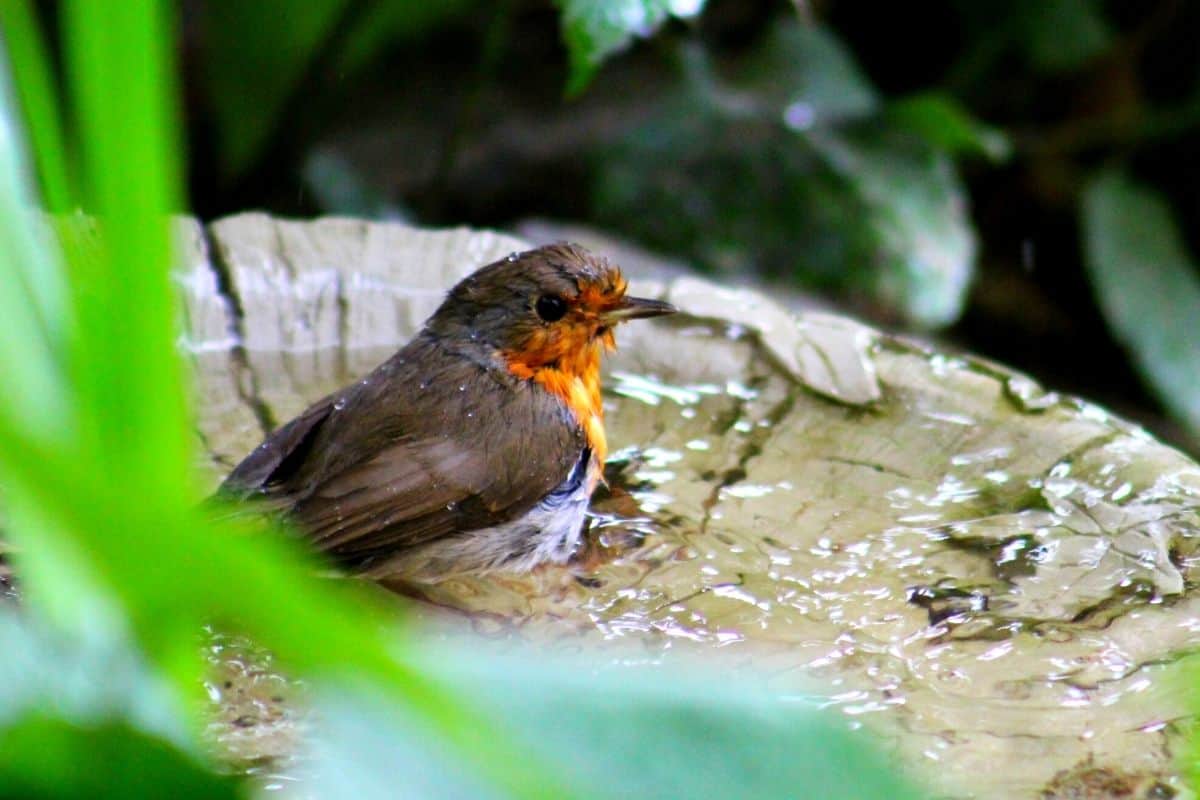
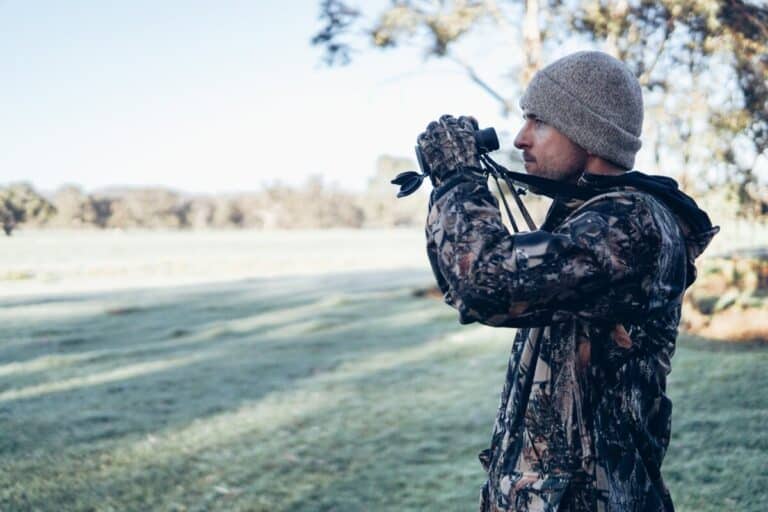
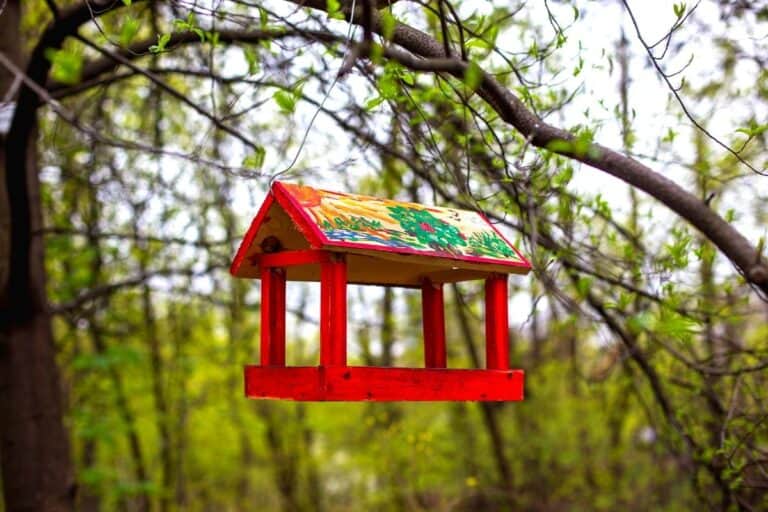
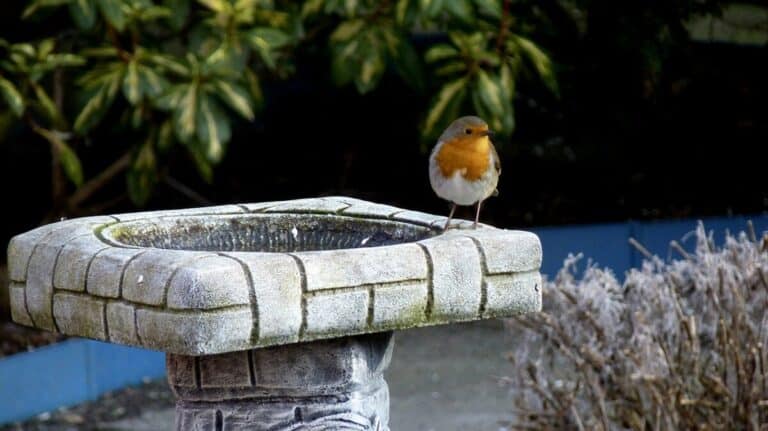
![How Many Bird Feeders Should You Have? [ANSWERED! + FAQs]](https://birdingoutdoors.com/wp-content/uploads/2021/06/feeders-2-768x512.jpg)

